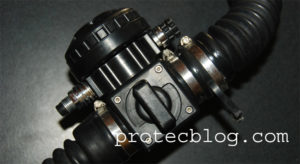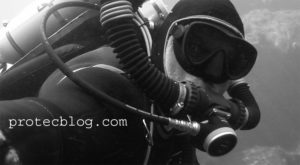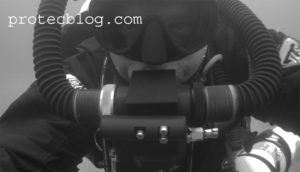A Bail Out Valve (BOV) is a Diver Surface Valve (DSV) that has a second stage regulator incorporated into the mouthpiece and is connected to either the onboard diluent tank or the off board bailout tank thus supplying the diver with open circuit breathing gas. A rebreather diver who is using a BOV is either on the loop breathing of his rebreather or on the regulator breathing open circuit enabling him to have a breathing source at all times.
There is a variety of BOV’s on the market now, some rebreathers are coming factory equipped and stock with a BOV while others can be fitted with aftermarket BOV’s. Most BOV’s have a drum within the mouth piece and when turned allowing breathing gas upon inhalation either be taken in from the rebreather or the open circuit regulator. Some BOV’s are very sophisticated with magnetic switches inside actually allowing the electronics to see if the diver is on the loop or on open circuit.
Why or why not to use a BOV seems to be a personal preference until you look a little deeper into it. Of course the opinion expressed here is my personal one but has developed through time while witnessing first hand events that could have been handled better with a BOV or hearing from other divers what happened to them. What I have witnessed over and over again is that divers do hesitate to long, way toooo loooong before they decide to go to bailout when they think something is not right. They start thinking about it, are not sure, they feel something is or was not right, don’t want to be embarrassed or think the process of bailing out is just to cumbersome and time consuming. The installation and use of a BOV does change that and can be a life saver.
It has happened that a diver managed to get in the water without Co2 absorbent in his unit, despite checklist and all that. As they went down at about 20 feet / 6 meters the diver was breathing uncontrolled due to exertion and very high Pco2, experiencing extreme hypercapnia. The dive partner realized what is going on and urged the his friend to switch to o/c. The unit was not equipped with a BOV. The diver was not able to make the switch as he was not able to hold his breath for even a split second to do the switch over. They went back up to the surface and both lived to tell the story. With a BOV the diver would have been able to switch from his rebreather to his o/c bail out without a problem and without the need to take his mouthpiece out of his mouth. Additionally the other diver could have intervened and help the affected diver while turning a simple knob on his friends BOV mouthpiece, helping the distressed and potentially incapacitated diver.
Something else I have witnessed with BOV equipped divers is that they tend not to think much about what gas they have in their BOV supply tank and use the BOV freely on the surface, and why not. It is that I just somewhat uncomfortably imagine as they go on with their diving career and coming to trimix diving that this habit will have them killed on the surface due to potentially hypoxia breathing a low o2 content hypoxic breathing mixture on the surface, possibly exerting while moving along the surface toward a down line or trying to catch up with a boat or drift line. As one habit might be good in one diving situation it may kill you in another.
Shall I connect the BOV to my inboard diluent tank or to my off board bailout tank. Well, that depends on the depth you want to dive at as usually your inboard diluent tank is rather small unless changed to a larger tank to allow such move. My thought is a bit deeper though. I believe that if I decide to go off my rebreather (SCR or CCR) then I am off and want to go to something that is not connected at all to my rebreather because my rebreather is my rebreather and my bailout is my bailout, separated entirely and not connected to one another. Personally my BOV is connected to the inboard diluent tank.

When doing that last switch over to your complete detached and separate bailout gas supply, you as well have decided you are not going back onto the rebreather as you have decided you do not trust it anymore, or it does not work anymore other then providing buoyancy. And you stick with it. And while you are at it change your set point to a low one or manual, open the over pressurization valve from your counter lungs as you will go up and if using electronics or dive computers with ccr – o/c capability do the witch there too. The BOV could be a life saver if used properly.
I have seen some divers who had their BOV plumed via disconnect into their o/c bailout stage tank and this way going onto your BOV you will not need to take the BOV out of your mouth to go onto your off board bailout tank, keeping your mouthpiece in your mouth to do a easy switch over and yet go off your rebreather onto a separate tank at once. That is fine if that is what you want to do but as I am feeling strongly about team diving I would still need to have a second stage regulator connected to my bailout tank in case my team mate is in need of bailout gas.
With the limited volume offered by the onboard diluent tank the BOV is just an important step in-between to get off the loop and then onto the separate bailout tank (I will discuss other than o/c bailout options in a future post). While taking a breath or three while on my BOV connected to my inboard diluent tank I have time and a controlled breathing gas while looking for my main bailout tank regulator, then go on to my large o/c bailout stage, which is a completely separate life support system with pre-calculated Po2 and gas volume.
If you just think about going off the loop and to bailout but cannot even put your finger on what or why, that very thought of just thinking about bailing out is the very reason to bail out, now. Do not hesitate a split second and go to o/c bailout, because that might have been your last chance to do so. The installation and use of a BOV can be a live saver. I currently have a BOV on almost all my rebreathers using a Golem Gear BOV on my CCR Megalodon and Inspiration, and manufacturer BOV with Classic KISS as well as P-SCR. The only exception being my CCR O2ptima who does not have a BOV, but I am sure thinking about installing one. In deep diving with higher Pata and with it higher Pco2′s or in cave diving when dealing with navigation in case of a breaking through, the fast need to switch over to bailout might warrant the use of a BOV with the added ability of your team mates to help and intervene if you are possibly incapacitated by hyperoxia, hypoxia or hypercapnia.
Matt



